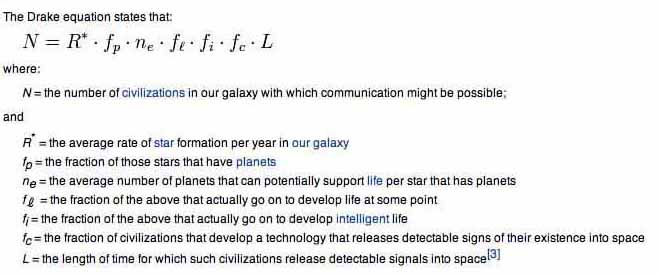



The Fermi paradox (Fermi's paradox or Fermi-paradox) is the apparent contradiction between high estimates of the probability of the existence of extraterrestrial civilizations and the lack of evidence for, or contact with, such civilizations.
The galaxy contains roughly a hundred billion stars. If even a very small fraction of these have planets which develop technological civilizations, there must be a very large number of such civilizations. If any of these civilizations produce cultures which colonize over interstellar distances, even at a small fraction of the speed of light, the galaxy should have been completely colonized in no more than a few million years. Since the galaxy is billions of years old, Earth should have been visited and colonized long ago. The absence of any evidence for such visits is the Fermi Paradox.
The Fermi Paradox is a physical paradox in which high estimates of the probability of the existence of extraterrestrial life are contrasted with a lack of evidence.
The age of the universe and its vast number of stars seem to suggest that extraterrestrial life should be common. Considering this with colleagues over lunch in 1950, the physicist Enrico Fermi is said to have asked: "Where are they? If there are a multitude of advanced extraterrestrial civilizations in the Milky Way galaxy then why have we not seen any evidence, such as probes, spacecraft or radio transmissions? The simple question "Where are they?" (alternatively, "Where is everybody?") is possibly apocryphal but Fermi is widely credited with simplifying and clarifying the problem of the probability of extraterrestrial life.
There have been attempts to resolve the Fermi Paradox by locating evidence of extraterrestrial civilizations, along with proposals that such life could exist without our knowledge. Counterarguments suggest that intelligent extraterrestrial life does not exist or at least occurs so rarely that we will never make contact with it. The belief that the lack of evidence conclusively demonstrates the non-existence of extraterrestrial civilizations is known as the Fermi principle.
A great deal of effort has gone into developing scientific theories and possible models of extraterrestrial life and the Fermi paradox has become a theoretical reference point in much of this work. The problem has spawned numerous scholarly works addressing it directly, while various questions that relate to it have been addressed in fields as diverse as astronomy, biology, ecology and philosophy. The emerging field of astrobiology has brought an interdisciplinary approach to the Fermi paradox and the question of extraterrestrial life.
The Fermi paradox is a conflict between an argument of scale and probability, and a lack of evidence. A more complete definition could be stated thus:
The first aspect of the paradox, "the argument by scale", is a function of the raw numbers involved: there are an estimated 250 billion stars in the Milky Way and seventy sextillion (7 x 1022) in the universe. Even if intelligent life occurs on only a minuscule percentage of planets, there should still be a great number of civilizations extant in our galaxy alone. This argument also assumes the mediocrity principle, which states that Earth is not special, but merely a typical planet, subject to the same laws, effects, and likely outcomes as any other world. Some estimates using the Drake equation support this argument, although the assumptions behind those calculations have themselves been challenged.
The second cornerstone of the Fermi paradox is a rejoinder to the argument by scale: given intelligent life's ability to overcome scarcity, and its tendency to colonize new habitats, we have assumed that any advanced civilization would seek out new resources and colonize first their solar system, and then surrounding solar systems. As there is no evidence on Earth or anywhere else of attempted alien colonization after 13 billion years of the universe's history, we must assume that intelligent life is rare in our part of the galaxy, or that our assumptions about the general behavior of intelligent species is flawed.
Several writers have tried to estimate how fast an alien civilization might spread through the galaxy. There have been estimates of anywhere from 5 million to 50 million years to colonize the entire galaxy; a relatively small amount of time on a geological scale, let alone a cosmological one. Even if colonization is impractical or undesirable to an alien civilization, large scale exploration of the galaxy is still possible with minor investment in energy and resources. The means of exploration and theoretical probes involved are discussed extensively below.
-
While numerous theories and principles attend to the Fermi paradox, the one most closely related is the Drake equation. It was formulated by Dr. Frank Drake in 1960, a decade after the objections raised by Enrico Fermi, in an attempt to find a systematic means to evaluate the numerous probabilities involved in alien life.

The Drake equation has been used by both optimists and pessimists, with varying results. Dr. Carl Sagan, for example, suggested as many 1 million communicating civilizations in the Milky Way in 1966, though he later wrote in his widely known book Cosmos that said number could be far smaller. Other published estimates from Frank Tipler place the value at just one - e.g., human beings are the only extant intelligent life.
Critics of the Drake equation claim that since the variables cannot yet be determined with any real confidence, estimating the number of extraterrestrial civilizations based on it is methodologically flawed, an idea which the wide divergence in estimates seems to support. Focusing on empirical data - which scientists are only now beginning to collect and analyze in a significant manner - rather than theory is the only sound approach. Only with further observation can meaningful values for the Drake equation factors be assigned.
The Rare Earth Hypothesis attempts to resolve the Fermi paradox by suggesting that Earth is not typical, but unusual, and perhaps even unique. This is a rejection of the mediocrity principle and supports the Fermi principle - that a lack of evidence equals a lack of extraterrestrial life. While a unique Earth has had historical support on philosophical or religious grounds, the Rare Earth Hypothesis deploys quantifiable and statistical arguments in support of the theory that multicellular life is exceedingly rare in the universe because Earth-like planets are themselves exceedingly rare. Supporters argue that many improbable coincidences have converged to make complex life on Earth possible.
Insofar as the Rare Earth Hypothesis privileges Earth-life and its process of formation, it is a variant of the anthropic principle. The Anthropic Principle notes that the universe seems uniquely suited to the development of human intelligence and that any variation in any one of a myriad of universal constants would make the development of intelligent life more difficult. This philosophical stance opposes not only "mediocrity", but the Copernican principle more generally, which suggests there is no privileged location in the universe.
Opponents dismiss both Rare Earth and the anthropic principle as tautological - if a condition must exist in the universe for human life to arise, then the universe must already meet that condition, as we are here - and as an unimaginative argument. According to this analysis, the Rare Earth hypothesis confuses a description of how life on Earth arose with a uniform conclusion of how life must arise. While the probability of the specific conditions on Earth being widely replicated may be low, complex life may not require exclusively Earth-like conditions in order to evolve. Read more ...
75 years after Fermi's paradox, are we any closer to finding alien life? PhysOrg - June 13, 2025

It was a simple question asked over lunch in 1950. Enrico Fermi, the Nobel Prize-winning physicist who helped usher in the atomic age, was dining with colleagues at Los Alamos, New Mexico, when the conversation turned to extraterrestrial life. Given the vastness of the universe and the statistical likelihood of other intelligent civilizations, Fermi wondered, "Where is everybody?" Seventy-five years later, David Charbonneau, a professor of astronomy at the Center for Astrophysics | Harvard & Smithsonian, says we're closer to an answer.
Some intelligent civilizations could be trapped on their worlds PhysOrg - February 28, 2024
Fishbowl Worlds: Aliens Could Be Highly Intelligent, But Unable To Contact The Outside IFL Science - February 29, 2024
Enrico Fermi and extraterrestrial intelligence PhysOrg - April 8, 2015
It's become a kind of legend, like Newton and the apple or George Washington and the cherry tree. One day in 1950, the great physicist Enrico Fermi sat down to lunch with colleagues at the Fuller Lodge at Los Alamos National Laboratory in New Mexico and came up with a powerful argument about the existence of extraterrestrial intelligence, the so-called "Fermi paradox". But like many legends, it's only partly true. Robert Gray explained the real history in a recent paper in the journal Astrobiology.


Crop Formation and the 1974 Arecibo Radio Transmission